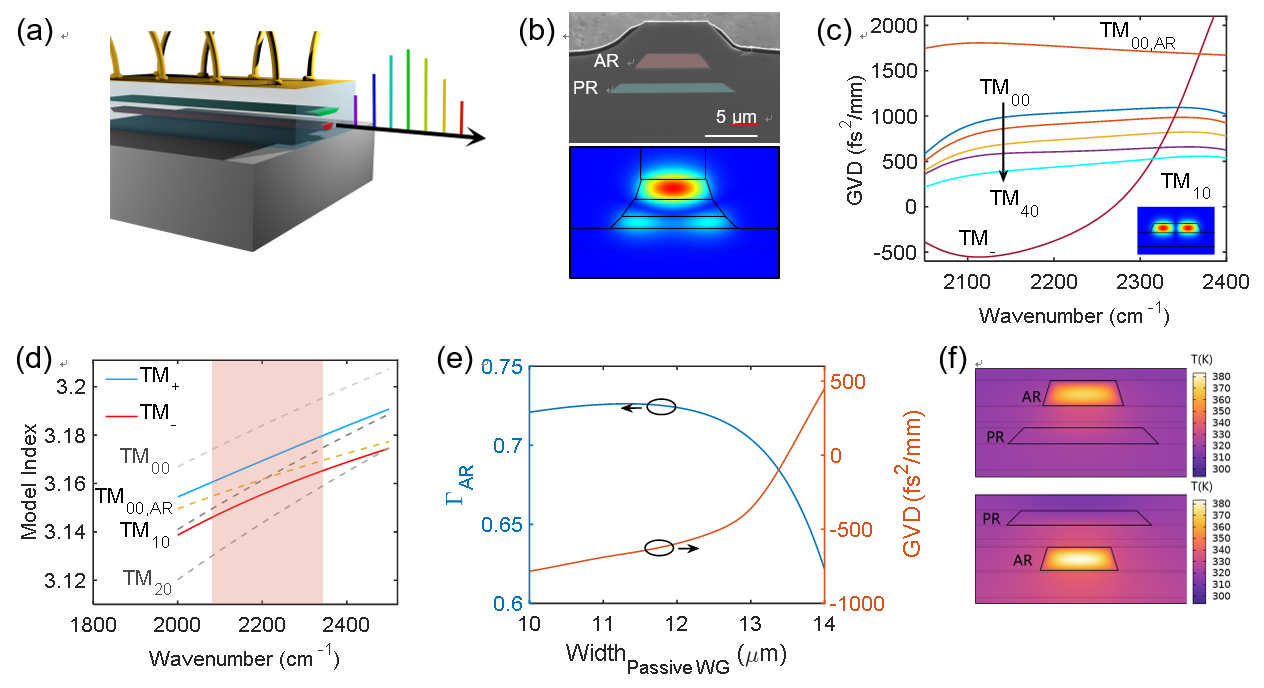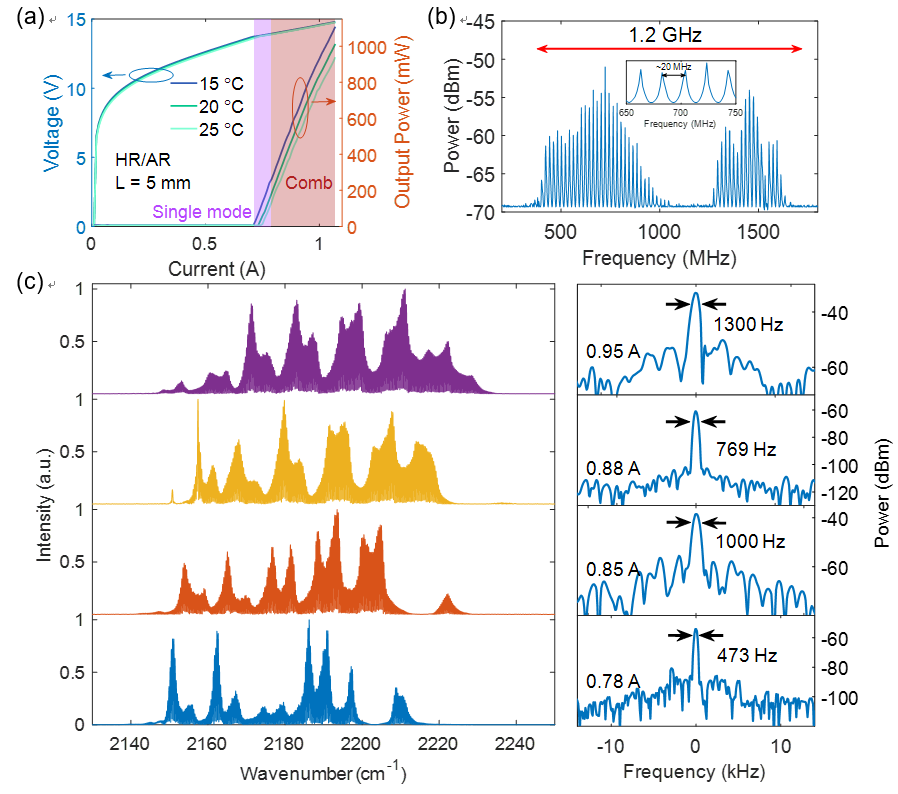A new progress in mid-infrared on-chip optical frequency comb
2024/11/08
Quantum Cascade Laser Frequency Comb (QCL-FC), as an emerging solid-state radiation source operating in the mid-infrared to terahertz spectral ranges, has attracted widespread attention for its application in fields such as rapid spectroscopy, sensing, and lidar. Recently, a research team led by Professor Quanyong Lu from the Beijing Academy of Quantum Information Sciences (referred to as the BAQIS) and Professor Fengqi Liu's team from the Institute of Semiconductors, CAS, including Professor Jinchuan Zhang and Shuman Liu, made significant progress in high-power mid-wave infrared quantum cascade laser frequency combs. This breakthrough lays the foundation for further advancements in high-precision on-chip sensing. On November 1st, 2024, their findings were published in the academic journal 《Photonics Research》under the title “Monolithic dispersion engineered mid-infrared quantum cascade laser frequency comb”.
The design of intersubband transitions in the active region features the QCL with fast gain characteristics. Under low pumping conditions, it can enter multimode operation through spatial hole-burning effects and the side-mode gain provided by population gratings. Once the active region is provided with sufficiently low group velocity dispersion (GVD) design, the intrinsically strong nonlinearity of the QCL can lock the intracavity modes into FC state. However, due to the narrower bandgap material compositions such as InGaAs in active region, larger amount dispersion is induced for the short wavelength 3-5 μm QCLs, which makes they difficult self start into FC operation. Therefore, a more stringent and efficient dispersion compensation scheme is required. Professor Quanyong Lu proposed a monolithic integrated multimode waveguide (MIMWG) dispersion compensation scheme based on evanescent wave coupling, in which a InGaAs passive waveguide with high refractive index is introduced below the active region. Then the high-order transverse modes in passive waveguide couples with the fundamental mode in active region to generate a supermode with low group velocity dispersion. Through appropriate waveguide design, the supermode can be confined in the active region as possible, enabling the device operate in a low-dispersion state, as shown in Figure 1.

Figure 1 a. Schematic of the MIMWG QCL frequency comb. b. Cross-sectional SEM image of the device (top) and simulated electric field profile of the asymmetric supermode (bottom). c. Simulated GVD of the asymmetric supermode, the fundamental mode in active region, and the different order modes in passive region. d. Modal indices of each mode, showing the anti-crossing effect in the modal indices of the two coupled modes. e. Variation of light confinement factor and GVD of the asymmetric supermode with the width of the passive waveguide. f. Thermal field distribution corresponding to two different relative positions of the active and passive waveguides.
This excellent thermal management design and effective dispersion compensation scheme enable the device to achieve a maximum lasing power over 1 W at room temperature, improving the power of the frequency comb device in this wavelength range by more than 10 times, the intermode beatnote linewidth below 1 kHz, and the maximum spectral coverage is over 95 cm?1. The dual-comb multiheterodyne spectrum exhibits clear dual-comb teeth, indicating a well-defined phase relationship among the comb modes, which validates the effectiveness of the MIMWG dispersion compensation scheme. Compared to single-mode coupled waveguides and facets coating dispersion compensation mechanisms, the MIMWG scheme stands out due to its excellent dispersion compensation performance and good compatibility with active-passive coupling technique, making it potentially valuable for research in mid-infrared photonic integrated circuits (PICs), on-chip sensing, and ring cavity frequency combs.

Figure 2 a. PIV test results of the device at 15°C, 20°C, and 25°C, with a maximum power over 1 W 20°C. b. Dual-comb spectrum after time-averaging algorithm correction, with a signal coverage of approximately 1.2 GHz. c. Spectra of the device at different bias currents and the corresponding intermode beatnote spectrum, with a maximum spectral coverage of 95 cm?1 and a beatnote linewidth below 1 kHz for most currents.
The first authors of this work are Dapeng Wu, a Ph.D. student from Institute of Semiconductor, CAS and intern at BAQIS, Yu Ma, a postdoctoral researcher from BAQIS, and Yongqiang Sun, a postdoctoral researcher from Institute of Semiconductor, CAS. Professor Quanyong Lu from BAQIS and Professor Jinchuan Zhang and Shuman Liu from the Institute of Semiconductor, CAS are the corresponding authors. This work was supported by the National Natural Science Foundation of China, Beijing Municipal Science & Technology Commission and other funding sources.
Link:https://www.nature.com/articles/s41377-024-01567-2
 中文
中文 Email
Email QCloud
QCloud Log in
Log in
